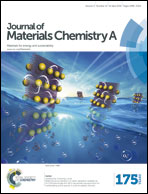Understanding the mechanism of hydrogenated NiCo2O4 nanograss supported on Ni foam for enhanced-performance supercapacitors†
Abstract
Spinel NiCo2O4 is considered a promising supercapacitive material because of its high theoretical capacity (greater than 3000 F g−1), nontoxicity, and safety. Here, we report that electrodes of porous NiCo2O4 nanograss grown in situ and supported on Ni foam achieved remarkable enhancement in electrochemical performance through facile hydrogenation at 300 °C for time periods of 1–4 h. The electrodes synthesized via 3 h of hydrogenation (H-NiCo2O4-3h) exhibited superior comprehensive electrochemical performance compared with the pristine pattern (air-annealed). The peak value of the area capacitance improved from the pristine 0.88 F cm−2 (338.5 F g−1) to 2.1 F cm−2 (807.7 F g−1) of H-3h, an increase of ∼240%. Additionally, the capacity retention from 1 to 30 mA cm−2 improved to a value of 71% (H-NiCo2O4-3h), which was superior to that of non-hydrogenated samples (54%). Furthermore, the long-cycling performance at 10 mA cm−2 exhibited a capacitance activation in H-NiCo2O4-3h within the first 1000 cycles, from 2.4 (923 F g−1) to 3.2 F cm−2 (1230 F g−1), and declined to 1.5 F cm−2 (577 F g−1) after another 2000 cycles; the last value is still greater than that of the pristine pattern (1.3 F cm−2 (500 F g−1)). The prominent electrochemical capacitive properties of hydrogenated NiCo2O4 are attributed to the enhancement in the electrical conductivity observed by an in situ TEM electrical test, resulting from the formation of oxygen vacancies in disordered surface layers (∼5 nm) observed in the hydrogenated samples based on in situ transmission electron microscopy characterization. Our findings provide a scientific explanation for the remarkable hydrogenation-induced electrochemical performance of cobalt oxide or binary nickel cobaltite compounds and offer a new route for the large-scale production of high-performance supercapacitor electrodes.


 Please wait while we load your content...
Please wait while we load your content...